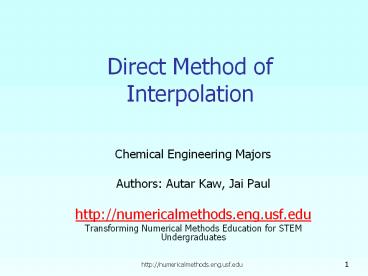Direct Method of Interpolation - PowerPoint PPT Presentation
Title:
Direct Method of Interpolation
Description:
Chemical Engineering Majors Authors: Autar Kaw, Jai Paul http://numericalmethods.eng.usf.edu Transforming Numerical Methods Education for STEM Undergraduates – PowerPoint PPT presentation
Number of Views:234
Avg rating:3.0/5.0
Title: Direct Method of Interpolation
1
Direct Method of Interpolation
- Chemical Engineering Majors
- Authors Autar Kaw, Jai Paul
- http//numericalmethods.eng.usf.edu
- Transforming Numerical Methods Education for STEM
Undergraduates
2
Direct Method of Interpolation
http//numericalmethods.eng.usf.edu
3
What is Interpolation ?
Given (x0,y0), (x1,y1), (xn,yn), find the
value of y at a value of x that is not given.
Figure 1 Interpolation of discrete.
4
Interpolants
- Polynomials are the most common choice of
interpolants because they are easy to
- Evaluate
- Differentiate, and
- Integrate
5
Direct Method
- Given n1 data points (x0,y0), (x1,y1),..
(xn,yn), - pass a polynomial of order n through the data
as given - below
- where a0, a1,. an are real constants.
- Set up n1 equations to find n1 constants.
- To find the value y at a given value of x,
simply substitute the value of x in the above
polynomial.
6
Example
- To find how much heat is required to bring a
kettle of water to its boiling point, you are
asked to calculate the specific heat of water at
61C. The specific heat of water is given as a
function of time in Table 1. Use linear,
quadratic and cubic interpolation to determine
the value of the specific heat at T 61C.
Table 1 Specific heat of water as a function of
temperature.
Temperature, Specific heat,
22 42 52 82 100 4181 4179 4186 4199 4217
Figure 2 Specific heat of water vs.
temperature.
7
Linear Interpolation
Solving the above two equations gives,
Hence
8
Quadratic Interpolation
Quadratic Interpolation
Solving the above three equations gives
9
Quadratic Interpolation (contd)
The absolute relative approximate error obtained
between the results from the first and second
order polynomial is
10
Cubic Interpolation
11
Cubic Interpolation (contd)
The absolute relative approximate error obtained
between the results from the first and second
order polynomial is
12
Comparison Table
13
Additional Resources
- For all resources on this topic such as digital
audiovisual lectures, primers, textbook chapters,
multiple-choice tests, worksheets in MATLAB,
MATHEMATICA, MathCad and MAPLE, blogs, related
physical problems, please visit - http//numericalmethods.eng.usf.edu/topics/direct
_method.html
14
- THE END
- http//numericalmethods.eng.usf.edu































